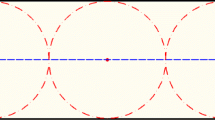Abstract
Thickness constraint is an important geometrical constraint in topology optimization methods. I present a novel approach of the thickness constraint based on the Fictitious Physical Model (FPM). The FPM is formulated using the similarity of the dispersive coefficient in high order homogenization. The thickness constraint is represented using the solutions of the linear partial deferential equation system. Its design sensitivity is derived using the adjoint variable method. Numerical example is shown to confirm the validity and utility of the proposed method using the level set-based topology optimization method. The main advantage of the proposed method is the allowance of thickness constraint violations during the optimization procedure. Furthermore, the thickness is computed without computing minimum distances from the boundaries of target shape.
Access this chapter
Tax calculation will be finalised at checkout
Purchases are for personal use only
Similar content being viewed by others
References
Allaire, G., Yamada, T.: Optimization of dispersive coefficients in the homogenization of the wave equation in periodic structures. Numer. Math. (2018, in press). https://hal.archives-ouvertes.fr/hal-01341082
Guest, J.K.: Imposing maximum length scale in topology optimization. Struct. Multi. Optim. 37(5), 463–473 (2009). https://doi.org/10.1007/s00158-008-0250-7
Guest, J.K., Prévost, J.H., Belytschko, T.: Achieving minimum length scale in topology optimization using nodal design variables and projection functions. Int. J. Numer. Methods Eng. 61(2), 238–254 (2004). https://doi.org/10.1002/nme.1064
Otomori, M., Yamada, T., Izui, K., Nishiwaki, S.: Matlab code for a level set-based topology optimization method using a reaction diffusion equation. Struct. Multi. Optim. 51(5), 1159–1172 (2015). https://doi.org/10.1007/s00158-014-1190-z
Poulsen, T.A.: A new scheme for imposing a minimum length scale in topology optimization. Int. J. Numer. Methods Eng. 57(6), 741–760 (2003). https://doi.org/10.1002/nme.694
Sato, Y., Yamada, T., Izui, K., Nishiwaki, S.: Manufacturability evaluation for molded parts using fictitious physical models, and its application in topology optimization. Int. J. Adv. Manufact. Technol. 92(1–4), 1391–1409 (2017). https://doi.org/10.1007/s00170-017-0218-0
Yamada, T., Izui, K., Nishiwaki, S., Takezawa, A.: A topology optimization method based on the level set method incorporating a fictitious interface energy. Comput. Methods Appl. Mech. Eng. 199(45), 2876–2891 (2010). https://doi.org/10.1016/j.cma.2010.05.013
Author information
Authors and Affiliations
Corresponding author
Editor information
Editors and Affiliations
Rights and permissions
Copyright information
© 2019 Springer Nature Switzerland AG
About this paper
Cite this paper
Yamada, T. (2019). Thickness Constraints for Topology Optimization Using the Fictitious Physical Model. In: Rodrigues, H., et al. EngOpt 2018 Proceedings of the 6th International Conference on Engineering Optimization. EngOpt 2018. Springer, Cham. https://doi.org/10.1007/978-3-319-97773-7_43
Download citation
DOI: https://doi.org/10.1007/978-3-319-97773-7_43
Published:
Publisher Name: Springer, Cham
Print ISBN: 978-3-319-97772-0
Online ISBN: 978-3-319-97773-7
eBook Packages: EngineeringEngineering (R0)




